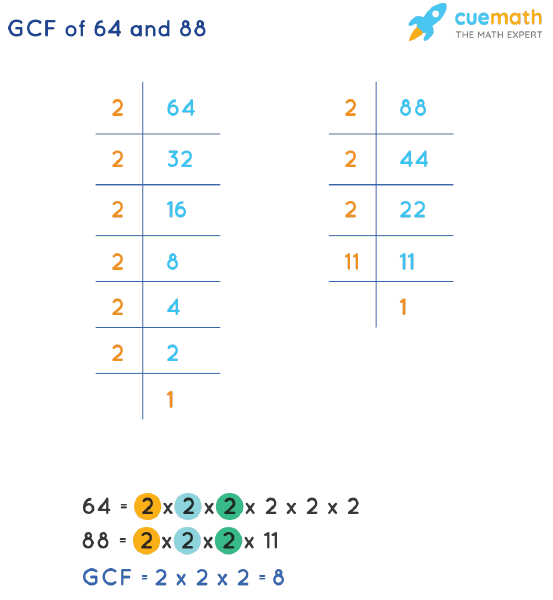GCF of 64 and 88
GCF of 64 and 88 is the largest possible number that divides 64 and 88 exactly without any remainder. The factors of 64 and 88 are 1, 2, 4, 8, 16, 32, 64 and 1, 2, 4, 8, 11, 22, 44, 88 respectively. There are 3 commonly used methods to find the GCF of 64 and 88 - long division, prime factorization, and Euclidean algorithm.
| 1. | GCF of 64 and 88 |
| 2. | List of Methods |
| 3. | Solved Examples |
| 4. | FAQs |
What is GCF of 64 and 88?
Answer: GCF of 64 and 88 is 8.

Explanation:
The GCF of two non-zero integers, x(64) and y(88), is the greatest positive integer m(8) that divides both x(64) and y(88) without any remainder.
Methods to Find GCF of 64 and 88
The methods to find the GCF of 64 and 88 are explained below.
- Using Euclid's Algorithm
- Listing Common Factors
- Prime Factorization Method
GCF of 64 and 88 by Euclidean Algorithm
As per the Euclidean Algorithm, GCF(X, Y) = GCF(Y, X mod Y)
where X > Y and mod is the modulo operator.
Here X = 88 and Y = 64
- GCF(88, 64) = GCF(64, 88 mod 64) = GCF(64, 24)
- GCF(64, 24) = GCF(24, 64 mod 24) = GCF(24, 16)
- GCF(24, 16) = GCF(16, 24 mod 16) = GCF(16, 8)
- GCF(16, 8) = GCF(8, 16 mod 8) = GCF(8, 0)
- GCF(8, 0) = 8 (∵ GCF(X, 0) = |X|, where X ≠ 0)
Therefore, the value of GCF of 64 and 88 is 8.
GCF of 64 and 88 by Listing Common Factors
- Factors of 64: 1, 2, 4, 8, 16, 32, 64
- Factors of 88: 1, 2, 4, 8, 11, 22, 44, 88
There are 4 common factors of 64 and 88, that are 8, 1, 2, and 4. Therefore, the greatest common factor of 64 and 88 is 8.
GCF of 64 and 88 by Prime Factorization

Prime factorization of 64 and 88 is (2 × 2 × 2 × 2 × 2 × 2) and (2 × 2 × 2 × 11) respectively. As visible, 64 and 88 have common prime factors. Hence, the GCF of 64 and 88 is 2 × 2 × 2 = 8.
☛ Also Check:
- GCF of 9 and 10 = 1
- GCF of 15 and 50 = 5
- GCF of 14 and 49 = 7
- GCF of 2 and 7 = 1
- GCF of 22 and 44 = 22
- GCF of 5 and 7 = 1
- GCF of 51 and 85 = 17
GCF of 64 and 88 Examples
-
Example 1: Find the greatest number that divides 64 and 88 exactly.
Solution:
The greatest number that divides 64 and 88 exactly is their greatest common factor, i.e. GCF of 64 and 88.
⇒ Factors of 64 and 88:- Factors of 64 = 1, 2, 4, 8, 16, 32, 64
- Factors of 88 = 1, 2, 4, 8, 11, 22, 44, 88
Therefore, the GCF of 64 and 88 is 8.
-
Example 2: The product of two numbers is 5632. If their GCF is 8, what is their LCM?
Solution:
Given: GCF = 8 and product of numbers = 5632
∵ LCM × GCF = product of numbers
⇒ LCM = Product/GCF = 5632/8
Therefore, the LCM is 704. -
Example 3: Find the GCF of 64 and 88, if their LCM is 704.
Solution:
∵ LCM × GCF = 64 × 88
⇒ GCF(64, 88) = (64 × 88)/704 = 8
Therefore, the greatest common factor of 64 and 88 is 8.

FAQs on GCF of 64 and 88
What is the GCF of 64 and 88?
The GCF of 64 and 88 is 8. To calculate the GCF (Greatest Common Factor) of 64 and 88, we need to factor each number (factors of 64 = 1, 2, 4, 8, 16, 32, 64; factors of 88 = 1, 2, 4, 8, 11, 22, 44, 88) and choose the greatest factor that exactly divides both 64 and 88, i.e., 8.
What are the Methods to Find GCF of 64 and 88?
There are three commonly used methods to find the GCF of 64 and 88.
- By Long Division
- By Euclidean Algorithm
- By Prime Factorization
If the GCF of 88 and 64 is 8, Find its LCM.
GCF(88, 64) × LCM(88, 64) = 88 × 64
Since the GCF of 88 and 64 = 8
⇒ 8 × LCM(88, 64) = 5632
Therefore, LCM = 704
☛ GCF Calculator
How to Find the GCF of 64 and 88 by Long Division Method?
To find the GCF of 64, 88 using long division method, 88 is divided by 64. The corresponding divisor (8) when remainder equals 0 is taken as GCF.
What is the Relation Between LCM and GCF of 64, 88?
The following equation can be used to express the relation between Least Common Multiple (LCM) and GCF of 64 and 88, i.e. GCF × LCM = 64 × 88.
How to Find the GCF of 64 and 88 by Prime Factorization?
To find the GCF of 64 and 88, we will find the prime factorization of the given numbers, i.e. 64 = 2 × 2 × 2 × 2 × 2 × 2; 88 = 2 × 2 × 2 × 11.
⇒ Since 2, 2, 2 are common terms in the prime factorization of 64 and 88. Hence, GCF(64, 88) = 2 × 2 × 2 = 8
☛ What is a Prime Number?
visual curriculum
